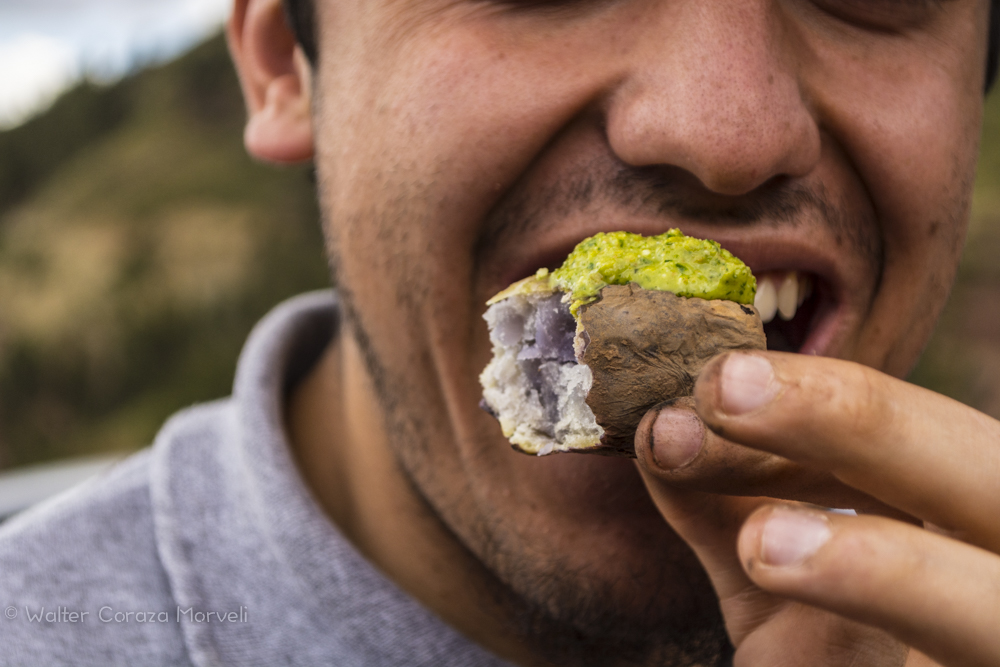The Joy of Potatoes and Uchukuta

Food is so many things to people, but one of the most important is taste which includes scent. I recently read an article by Jeffrey Pilcher in which he noted that food scholars are increasingly studying profiles of taste in different places, how they vary by class and ethnicity in those places, and how they are changing with the onslaught of globalization.
Pilcher expressed the common argument that the industrial food regime is changing the profile to include sweetness as a primary kind of taste. I certainly see this in the US when I go out to eat. Dish after dish is becoming a sugar bowl.
Pilcher’s article then reviewed the diversity of flavor profiles in Mexico over time. This made me think of Peru, and particularly Cusco. Though I am far away, I want to lay down some ideas that I see of flavor and its diversity and changes in the Imperial City and its region.
At the base of everything in Cusco is the boiled potato. The wetness, starchiness, and complex, substantial flavor with depth varies from variety to variety, and their are dozens if not hundreds of varieties of potatoes here, and hence from place to place.
This seems to be key to what people describe as misk’iy, in Quechua, which is a complex word that is often simply glossed as “sweet” or delicious, though it is far from sugary. It is just not sharp or bitter, like the potatoes used more from freeze-drying.

The boiled potato contrasts with the potato baked in the earth, the huatia, that people love in its season. This form of cooking concentrates and darkens a bit the flavor of the potatoes flesh and gives it a bit of taste of fire and of earth. In fact, the contrast of water and earth, seems to be the basic contrast between these two experiences of potatoes.
It is not just the potato, however. Whether boiled or baked, potatoes are eaten with an uchukuta, a ground hot sauce, that is sharp, a bit sour, and complex. Besides the heat from the rocoto, the most common local hot pepper, which is biting and bright, the sauce has herbs, from the asnapa, or bundle of herbs sold in the market (including cilantro, huacatay, mint, parsley, and often rue).

The complex scent and flavor of huacatay is basic to Cusco’s uchukutas. It is pungent and green, carrying notes of anise and cinnamon While strong, it is also a bit sweet, though not sugary. It is a scent and flavor unknown and strong to the palates of many outsiders. Certainly in coastal Peru they prefer cilantro in their hot sauce and when they use huacatay, they prefer it in less quantity than in Cusco. Sometimes the uchukuta is light cooked and sometimes it is raw. In all cases it is thick and clings to the potatoes, providing a contrast of two flavors: the herby, spicy, and creamy uchukuta and the starchy yet flavorful potato, whether baked or boiled.
In this, another common flavor contrast on the plate is with meat, either baked, fried, or even boiled. The uchukuta bridges the differences of chicken, pork, beef, or guinea pig, on the plate, each with their own flavors and texture depending on mode of preparation, and the potatoes. The hot sauce goes on all.
As a new flavor regime comes in from the coasts, typified in pollo a la brasa, rotisserie chicken, we find a salty juicy bird with a crispy and savory condimented skin accompanied by French fries, fried potatoes, whose main flavor is like the chicken light-brown and savory, while also lightly greasy. The cremas, as they they are called, that go with both are not generally the uchukuta with its strong herby flavor of huacatay and its thickness. These are lighter and runnier. The basic is mayonnaise without herbs, dairy or hot peppers. Its base is an emulsion of lime juice and oils, with a little egg to help emulsify. You also find a light catchup, which does bring a sweet, sugary note with the light tang of tomatoes and vinegar.
There is so much more I can write yet I realize this little set of potatoes, sauces (hot peppers), and meat is basic and can be much more deeply explored.
Cuzco has a distinctive profile of flavors. Though change is happening, something in this nexus of potatoes and uchukuta is basic and keeps it going as distinctive. The potato, humble and yet complex, makes the food.
Jeffrey M. Pilcher, “Taste, Smell, and Flavor in Mexico”, Latin American History (March 2016).




